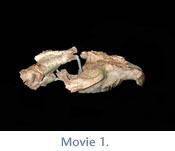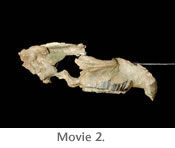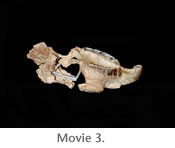Materials and Methods
The fossils described in this report are housed at the Florida Museum of Natural History in Gainesville, Florida, USA and the Facultad de Ingeniería Geológica of the Universidad Autónoma Tomás Frías, in Potosí, Bolivia. Measurements of these specimens were made to the nearest 0.1 mm using digital calipers. Comparative data were taken from the literature or gathered by DAC from original specimens. In addition to Cerdas, this study focuses on material from Choquecota, Quebrada Honda, and Nazareno in Bolivia and Chucal in Chile (Villarroel 1974b;
Oiso 1991;
Flynn et al. 2002;
Croft et al. 2004,
2007;
Croft 2007). In the following systematic review, single quotation marks are used to indicate uncertainty in taxonomic designations. We evaluated data on mesotheriines from both Choquecota and Quebrada Honda, but chose not to include them in these analyses because each locality has few or a single specimen.
Phylogenetic Analyses
To assess the phylogenetic position of the mesotheriine material from Cerdas (presumably P. minus), UF 133803 (the well-preserved skull) and mandibular specimens were added to the character-taxon matrix of
Croft et al. (2004). Ordering of character states followed
Croft et al. (2004). We corrected an error in the taxon list of
Croft et al. (2004), repeated from
Cerdeño and Montalvo (2001), listing Pseudotypotherium hystatum as Mesotherium hystatum. Recently studies (e.g.,
Cerdeño and Montalvo 2001;
Reguero and Castro 2004) support the referral of this species to Pseudotypotherium, following
Cabrera's (1937) original description. Trees were generated using the heuristic search option in PAUP 3.11 for the Macintosh computer, and character evaluation was performed in MacClade for the Macintosh. OTUs with multiple character states were considered polymorphic. Multiple specimens were used to code each species, when possible.
Metric Analyses
 Dental dimensions (length and width of M1 and m2) were used to evaluate size variation among specimens. These data were evaluated visually using bivariate plots and statistically using the coefficient of variation (CV), calculated as the standard deviation divided by the sample mean, multiplied by 100 (Sokal and Rohlf 1995). Because the coefficient of variation is biased to underestimate relative variation, a correction factor was used for small samples (i.e., those < 10;
Sokal and Rohlf 1995):
Dental dimensions (length and width of M1 and m2) were used to evaluate size variation among specimens. These data were evaluated visually using bivariate plots and statistically using the coefficient of variation (CV), calculated as the standard deviation divided by the sample mean, multiplied by 100 (Sokal and Rohlf 1995). Because the coefficient of variation is biased to underestimate relative variation, a correction factor was used for small samples (i.e., those < 10;
Sokal and Rohlf 1995):
Viewing the Specimen On-line
 We have provided three QuickTime movies illustrating dorsal,
Movie 1; palatal,
Movie 2, and laterally
Movie 3 rotating views of UF
133803.
We have provided three QuickTime movies illustrating dorsal,
Movie 1; palatal,
Movie 2, and laterally
Movie 3 rotating views of UF
133803.
These movies are a dynamic means of viewing characters that might be less apparent in a photograph. These movies were built using Easypano Modelweaver and are imbedded in a program that allows the viewer to virtually manipulate the specimen.
Abbreviations and Definitions
 GB, Servicio Geológico de Bolivia; SGO PV, vertebrate paleontology collections, Museo Nacional de Historia Natural, Santiago, Chile; UATF, Universidad Autónoma Tomás Frías, Potosí, Bolivia; UF, Florida Museum of Natural History, Gainesville; cm, centimeter; Ma, megannum; mm, millimeter; SALMA, South American Land Mammal "Age"; upper case letters (e.g., M1) refer to maxillary dentition; lower case letters (e.g., m1) refer to mandibular dentition. Length refers to mesio-distal length, and width refers to bucco-lingual width.
GB, Servicio Geológico de Bolivia; SGO PV, vertebrate paleontology collections, Museo Nacional de Historia Natural, Santiago, Chile; UATF, Universidad Autónoma Tomás Frías, Potosí, Bolivia; UF, Florida Museum of Natural History, Gainesville; cm, centimeter; Ma, megannum; mm, millimeter; SALMA, South American Land Mammal "Age"; upper case letters (e.g., M1) refer to maxillary dentition; lower case letters (e.g., m1) refer to mandibular dentition. Length refers to mesio-distal length, and width refers to bucco-lingual width.